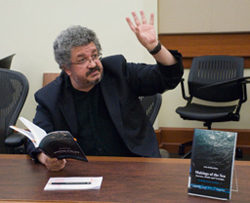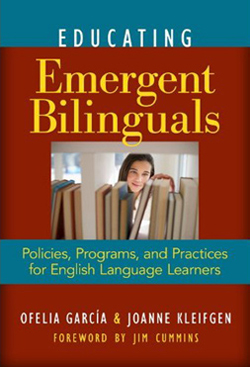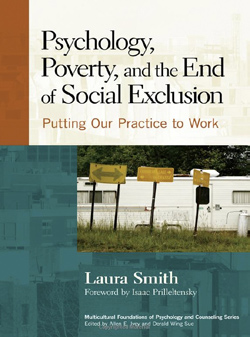Filed Under > Research/Publications
Winter Reading
Is there a Mediterranean aesthetic? How should the issue of social class play influence the practice of psychotherapists? And is the United States missing a potential asset in the way it defines and educates bilingual students? These are the central questions addressed, respectively, in books by John Baldacchino, Laura Smith and JoAnne Kleifgen.
Four new books by TC faculty members
by Emily Rosenbaum
Makings of the Sea: Journey, Doubt and Nostalgia
By John Baldacchino
Aside from their stature in the literary canon, what do Franz Fanon, Lord Byron and Nikos Kazantzakis have in common?
According to John Baldacchino, TC Associate Professor of Art Education, their common thread is the Mediterranean, in that its geopolitical landscape has provided much inspiration in their respective artistic works. Fanon touched upon the region in The Wretched of the Earth, a book about the Algerian struggle for independence from colonial rule; Byron traveled through the region in the early 19th century, landing in Italy for two years, on a trip that would greatly influence his Romantic poetry; and Kazantzakis, a Greek native, embodies the spirit of the region in vivid characters in works such as The Last Temptation of Christ and Zorba The Greek.
Weaving together many disparate aesthetic threads, Baldacchino sets out to consider art in the Mediterranean region, in his new book Makings of the Sea: Journey, Doubt and Nostalgia (Gorgias Press, 2010). While much has been written on Hellenism and Orientalism, there is very little theory that considers the Mediterranean region as a whole. In Baldacchino’s view, the Mediterranean Sea influences the artistic endeavors, including music, art and literature, of all the nations that surround it.
One common theme that much of the art emerging from Mediterranean cultures, Baldacchino writes, is the concept of the horizon, which looms large in the imaginations of denizens of the region.
“Nowhere is the horizon ever more present than in the vision of the sea, in whose apparent expanse the imagination merges poetic hopes with stoic perseverance,” he writes. As in The Odyssey, the sea, with its horizon, offers a promise of journey paired with nostalgia—a yearning to return.
The region, however, is too vast to be defined by simple labels. “Mediterranean” refers to the Middle East, the Balkans, North Africa and Spain, to name a few. “As we seek to affirm a semblance of a common humanity that marks out the Mediterranean from other regions, we also stumble on facts and acts that flatly refute this distinction,” Baldacchino writes. “And yet, Mediterraneans would tell you that in their experience, the notion of feeling at home—a sort of a Mediterranean Heimlich—across the region transcends language, religion, colour or custom.”
Baldacchino writes of “the Mediterranean persona where the realization of love, duty and happiness render irrelevant any Platonic division between art and beauty, the body and the soul.”
So vast is this subject, when Baldacchino started writing, he soon realized that his explorations would merit more than one book. Makings of the Sea is the first of three volumes on the topic.
To view a talk by Baldacchino about his book, visit http://bit.ly/eKUq3s
Educating Emergent Bilinguals: Policies, Programs, and Practices for English Language Learners
By Ofelia Garcia and Jo Anne Kleifgen
“Bilingualism is like an all-terrain vehicle,” write Ofelia Garcia and Jo Anne Kleifgen in their new book, Educating Emergent Bilinguals: Policies, Programs, and Practices for English Language Learners (Teachers College Press, 2010). People use it “to adapt to both the ridges and craters of communication in uneven terrain.” Yet, despite a wealth of research verifying the benefits of speaking more than one language, students who are in the process of adding English to the language spoken in their homes are tagged with deficit-oriented labels such as limited English proficient and English language learners. Garcia and Kleifgen call for society to use another term, emergent bilinguals, so that “students are seen instead for their potential to become bilingual, and bilingualism begins to be recognized as a cognitive, social, and educational resource.”
The authors argue that current negative labels result in part from emergent bilinguals—most of whom have difficulty using English for academic functions in classrooms—being subjected to mandated tests or sink-or-swim language emersion programs. When they can’t meet these unfair challenges, these students are frequently left out of gifted programs or put in double periods for course in English as a second language that have low content. Thus the perception of limited proficiency becomes a self-fulfilling prophecy.
Garcia and Kleifgen propose treating the potential to be bilingual as an asset. Their book is filled with suggestions for how to do this, such as scaffolding the students’ existing language practices. With changes in policy and practice that reflect the research in the field, they write, “Educators can bring bilingualism into play as an important resource not only for emergent bilinguals but also for the growing bilingual student population in the United States and for those who are speakers of English only and potentially emergent bilinguals themselves.”
Psychology, Poverty, and the End of Exclusion: Putting Our Practice to Work
By Laura Smith
“Don’t ever be ashamed of your people. They worked hard all their lives.”
Laura Smith, TC Assistant Professor of Counseling and Clinical Psychology, took these words, spoken by her grandfather at the kitchen table, to heart. Hailing from the mountains of Appalachia, in West Virginia, Smith’s family was poor and hard-working. Yet, as Smith recounts, this pairing—poverty and strength—has not been well-represented in a mainstream media that depicts poor mountain people as “dysfunctional in-breeders, lazy moonshiners or the Beverly Hillbillies.”
In her new book, Psychology, Poverty, and the End of Social Exclusion: Putting Our Practice to Work, published in August by Teachers College Press, Smith calls for “a new perspective to our understanding of poverty…that will suggest new horizons of service and advocacy that go beyond sympathy, charity, and conventional treatment modalities.” In other words, poverty is not simply a lack of money: it is a dynamic within the larger context of social class and hierarchy that should be considered by therapists who provide counseling to those who are poor.
“In the psychology field, there are lots of sincere altruistic intentions,” says Smith. “My hope is that this book will invite people to take a step back and look at the whole system.”
For clinicians, whose primary focus is the one-on-one relationship with clients, the idea of considering social hierarchy is relatively new. “It’s just not a traditional part of how we work,” says Smith, who points out that mental health professionals must also examine how they, too, are part of the system. That is: What is the therapist’s own hierarchical position, and how might that be relevant in the clinical setting?
Psychology, Poverty, and the End of Social Exclusion provides concrete methods for professionals to incorporate such new considerations in their daily practices.
One such approach is for the therapist to co-create therapeutic experiences with individual patients or even an entire community. Smith recalls the time she was working in concert with a community-based organization in a poor area, and community members expressed a need for additional therapeutic components to supplement talk therapy. Smith collaborated with the organization’s staff and community members to figure out what these additional components might be. After much discussion and reflection, a program was collaboratively designed to support “whole person emotional well-being”—which, in the case of this community, meant including education and vocational resources to lessen the sense of isolation and loneliness that many youth had reported in the face of limited neighborhood opportunities. As one 19 year old had put it to Smith, “What can I do? I don’t play sports, I don’t play music, and I don’t want to sell drugs.”
Drawing on extensive research from her colleagues, Smith also dedicates a chapter of her book to first-hand accounts of people living in poverty, to bring their stories, feelings and opinions to light. Of poverty in general, Theresa Funicello, a welfare mother, says, “How do you make public what so many people more powerful than you are trying their damndest to keep secret?” For Smith, writing Psychology, Poverty, and the End of Social Exclusion has been part of the answer.
Published Monday, Dec. 20, 2010


